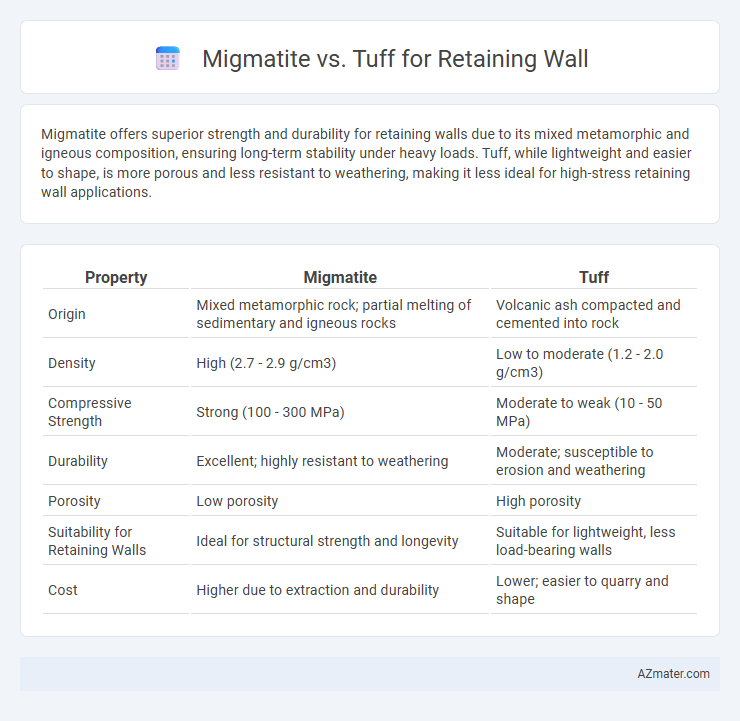Migmatite offers superior strength and durability for retaining walls due to its mixed metamorphic and igneous composition, ensuring long-term stability under heavy loads. Tuff, while lightweight and easier to shape, is more porous and less resistant to weathering, making it less ideal for high-stress retaining wall applications.
Table of Comparison
| Property | Migmatite | Tuff |
|---|---|---|
| Origin | Mixed metamorphic rock; partial melting of sedimentary and igneous rocks | Volcanic ash compacted and cemented into rock |
| Density | High (2.7 - 2.9 g/cm3) | Low to moderate (1.2 - 2.0 g/cm3) |
| Compressive Strength | Strong (100 - 300 MPa) | Moderate to weak (10 - 50 MPa) |
| Durability | Excellent; highly resistant to weathering | Moderate; susceptible to erosion and weathering |
| Porosity | Low porosity | High porosity |
| Suitability for Retaining Walls | Ideal for structural strength and longevity | Suitable for lightweight, less load-bearing walls |
| Cost | Higher due to extraction and durability | Lower; easier to quarry and shape |
Introduction to Migmatite and Tuff
Migmatite is a composite rock formed through partial melting of metamorphic rocks, resulting in a mixture of igneous and metamorphic components that provide high strength and durability. Tuff is a volcanic rock composed of compacted ash, characterized by lower density and porosity, which affects its load-bearing capacity and weather resistance. Understanding the mineral composition, porosity, and structural integrity of migmatite and tuff is crucial for selecting appropriate materials in retaining wall construction.
Geological Formation and Composition
Migmatite forms through high-grade metamorphism involving partial melting of pre-existing rocks, resulting in a mixed texture of igneous and metamorphic components primarily composed of quartz, feldspar, and mica. Tuff originates from volcanic ash deposits that consolidate into a porous rock rich in volcanic glass and fragmented minerals such as feldspar and quartz. The dense, interlocking crystals in migmatite provide superior strength and durability for retaining walls compared to the more brittle and porous nature of tuff.
Physical Properties Comparison
Migmatite exhibits high compressive strength and low porosity, making it durable and resistant to weathering, ideal for retaining wall stability. Tuff, a volcanic ash rock, tends to have lower density and higher porosity, which can reduce its load-bearing capacity and increase susceptibility to water infiltration. The superior hardness and abrasion resistance of migmatite contribute to longer-lasting structural integrity compared to tuff in retaining wall applications.
Durability and Weather Resistance
Migmatite offers superior durability and exceptional weather resistance due to its metamorphic composition and tightly interlocked mineral grains, making it highly suitable for retaining walls exposed to harsh environmental conditions. Tuff, a volcanic ash rock, is generally softer and more porous, which can lead to faster weathering and reduced structural longevity when used in retaining walls. For long-term performance and minimal maintenance, migmatite is the preferred choice over tuff in retaining wall construction.
Aesthetic Qualities and Visual Appeal
Migmatite offers a striking aesthetic with its intricate blend of metamorphic and igneous patterns, providing natural swirls of gray, white, and pink tones that create a unique, luxurious appearance for retaining walls. Tuff, composed of volcanic ash, presents a porous texture and earthy hues like soft browns, reds, and beiges, giving retaining walls a rustic and aged charm that blends well with natural landscapes. Both materials enhance visual appeal, with migmatite excelling in sophisticated elegance and tuff delivering a more rugged, organic look.
Structural Performance in Retaining Walls
Migmatite offers superior structural performance for retaining walls due to its high strength, durability, and resistance to weathering, making it ideal for load-bearing applications. Tuff, a volcanic ash-based rock, is lighter and more porous, resulting in lower compressive strength and reduced long-term stability under heavy loads. The dense, interlocking mineral composition of migmatite ensures better resistance to erosion and lateral earth pressure, enhancing its reliability in retaining wall construction compared to tuff.
Ease of Sourcing and Availability
Migmatite is typically more challenging to source due to its limited geographic distribution and the requirement for specialized quarrying techniques, often resulting in higher costs and longer lead times. Tuff, formed from volcanic ash, is more widely available and easier to extract in regions with volcanic activity, making it a cost-effective and readily accessible option for retaining wall construction. The abundance of tuff in specific areas significantly enhances project feasibility when ease of sourcing and availability are key considerations.
Environmental Impact and Sustainability
Migmatite offers higher durability and low permeability, reducing soil erosion and minimizing environmental disturbance when used for retaining walls. Tuff, a lightweight volcanic rock, provides better thermal insulation but may weather faster, potentially requiring more frequent maintenance and increasing resource consumption. Choosing Migmatite supports long-term sustainability by ensuring structural stability and lower environmental footprint through reduced material degradation and maintenance needs.
Cost Analysis: Migmatite vs Tuff
Migmatite offers a higher initial cost compared to Tuff due to its dense structure and extraction difficulty, but it provides superior durability and requires less maintenance over time, potentially reducing long-term expenses. Tuff is more affordable upfront because of its porous nature and widespread availability, but it may incur higher maintenance costs due to its susceptibility to weathering and erosion. Cost analysis favors Migmatite for projects prioritizing longevity and low upkeep, while Tuff suits budget-conscious constructions with shorter lifecycle expectations.
Best Applications and Recommendations
Migmatite offers superior durability and strength, making it ideal for retaining walls in areas prone to heavy loads and erosion, while tuff, being more porous and lightweight, suits decorative or low-load applications where drainage is critical. The best application for migmatite includes structural retaining walls in mountainous or high-stress environments, whereas tuff excels in garden landscaping and softer soil conditions due to its ease of cutting and shaping. For long-term stability and resistance to weathering, engineers recommend migmatite, whereas tuff is preferred for cost-effective projects requiring moderate support and enhanced aesthetics.

Infographic: Migmatite vs Tuff for Retaining Wall
 azmater.com
azmater.com